Are you dreaming of vases full of fresh flowers? Then it’s time to plant a cut flower garden! It’s easy when you follow this simple three-step process: choose the right location, select a variety of flowers, and plan for proper care. Then get ready to fall in love with your beautiful and thriving garden full of gorgeous blooms that you can cut and enjoy in arrangements and bouquets, anytime that you wish.
First Step: Choose the Right Location
When selecting a location for your cut flower garden, it’s important to consider the amount of sunlight it will receive. Most cut flowers need at least six hours of sunlight per day to thrive. You can gauge the amount of sun by keeping an eye on your possible locations as the day progresses, unless you already know where the sunniest locations are. A good measure of the sunny side of your house, is the window blinds that you have to close because the sun is glaring through them. This will almost always be the south, west, or southwest direction. You’ll also want to choose a spot that is easily accessible so you don’t have to do calisthenics to cut and care for those dazzling blossoms.
Step Two: Select a Variety of Flowers
To create a beautiful and diverse cut flower garden, choose a variety of flowers with different colors, shapes, and bloom times. This will allow you to have a range of flowers to choose from throughout the entire growing season. To give you some inspiration, we’ve compiled a list of the 13 best flowering plants to grow to fill your vases and decorate your landscape. These flowers are all known for their long stems and vibrant, colorful petals, making them perfect for use in a wide range of arrangements. You can even plan for spring-colored blossoms for spring & summer, and then enjoy the oranges and reds of fall as the season comes to an end. Try to choose flowers that bloom at different times so there is non-stop color in both your yard and home. Our suggestions are relatively easy to care for and can thrive in a variety of different climates and soil types. So if you want to create a cut flower garden that will be the envy of your neighborhood, and make your home your ‘happiest place’, be sure to consider these amazing flowering plants!

Zinnias are a summer essential with their bright and cheerful blossoms in oodles of colors, from snowy white to brilliant red, and just about every hue in between. These easy-to-grow cutting flowers are a great choice for beginning gardeners; they are reliable growers and prolific flower producers, blooming from summer up to the first frost. Zinnias thrive in USDA Zones 2 – 11 and will reward you with a bumper crop if you mix some organic material into your flower bed. Cut Zinnias when the flowers are fully open and enjoy them throughout your home for 7-10 days, the vase-life of fresh Zinnia cuttings.
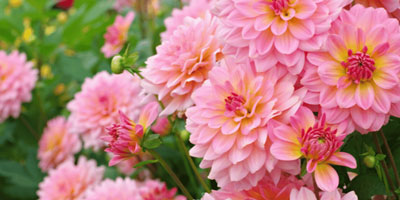
Dahlias are a top pick for any cut flower garden and are in the same family as Zinnias and Daisies. In fact, they are quite often mistaken for Zinnias. Dahlia plants grow quickly and are available in a wide range of colors and versatile shapes that resemble daisies, peonies, and even water lilies. These beautiful plants are highly productive, blooming from midsummer until the first autumn frost. When cutting Dahlias, be sure to pick them almost fully open but not overly ripe. Check the back of the flower head for firm, lush petals – if they are papery or dehydrated-looking, the blossoms are past their prime. Dahlia flowers usually last 4–5 days in vases, though you can extend their vase life by a couple of days by using flower food in the water. Dahlias can survive the winter in USDA Zones 8–10 and are grown as an annual in zones 3–7.

These delicate flowers, also known as Papaver, are prized for their tissue paper-like petals and vibrant colors. Poppies have an aromatic, citrusy fragrance and are known for their long flowering period. Poppies are one of the earliest cut flowers to blossom, flowers appearing in the spring and blooming into early summer; they will, however, go dormant with the heat of the summer, so plant with other later blooming plants. When harvesting Poppies, cut them at the “cracked bud” stage, just before the flowers burst from the bud. When you can see the color peeking through the bud casing, they are ready to pick. The blooms will pop while in the vase, extending the vase life by a couple of days. One stem can give you up to a week of flowers as some flowers fade and others open.

Peonies are known as the ‘queen’ of spring flowers, and it’s easy to see why. These elegant blooms are quite showy and available in a wide range of unique colors, from ivory to red; there is even a true blue cultivar. Peonies are also quite fragrant, being described as sweet and rosy or citrusy and spicy, depending upon the variety. Peony plants are a perennial in USDA Zones 3–8; actually growing and flowering best when exposed to cold winters. Peonies may be challenged in Zone 8 and are not recommended for Zones 9–11. They are long-lasting when cut and easy to grow and maintain. For the longest vase life, harvest Peonies while they are still in bud, aiming for that “soft marshmallow” stage, just before the bud opens. It is a myth that Peonies need ants to bloom; the truth is that ants will protect the blossoms from floral eating pests, while the Peony provides sweet nectar for the ants, a win-win for both.
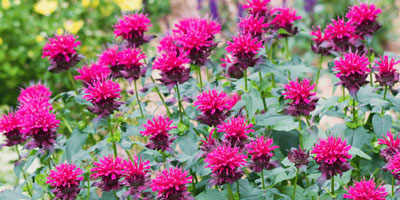
Monarda, also known as Bee Balm, is another great choice for a cut flower garden. Even small plantings will produce an impressive amount of blossoms. Monarda is prized for its unique coloration, the blossoms rising above foliage that is grayish-green. Monarda plants are available in shades of pale, soft purple to scarlet red. Due to their smaller whorl-shaped blooms, Monarda cuttings are often used as an accent or filler in vases. We recommend you harvest in the cooler morning temperatures, as Monarda flowers are likely to wilt if cut in the heat of the day. Monarda has a long vase life of 7–10 days, provided you use a flower preservative. This perennial flowering plant will thrive in USDA Zones 3–9.

Lilies are a classic choice for any cut flower garden due to their long-lasting blooms and variety of vibrant colors. There is a reason that cut Lilies are used often by professional florists; their vase life is 10–14 days! Lily plants grow on a bulb, with the bulbs multiplying each year, growing into large clumps with tons of blossoms. There is no need to bring the bulbs in for the winter; Lilies are cold hardy in USDA Zones 4–9. Cut your Lily flowers when the buds are just about to open, preferably in early morning so as not to stress the blossoms. We recommend you immediately put them into cool water. Using floral preservative in the water will help the petals retain their color from bud to full bloom and extend the vase life of your Lily flowers.
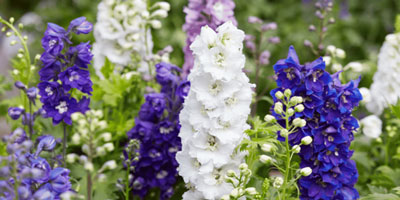
Delphiniums are also called Larkspur and are a regal choice for any cut flower garden, with their beautifully flowered spikes on strong stems that rise above many other flowers in the garden. Most commonly appreciated in a myriad of blue hues, purple, white and pink are also available. Most Delphinium flowers will have black centers, called “bees”, though newer cultivars often sport white centers. An herbaceous perennial (meaning the flowers die back every year, while the roots stay alive to produce more blossoms next year), Delphinium plants will thrive in USDA Zones 3–7. They are also grown in Zones 8 & 9, with afternoon shade to shelter them from the heat and extreme temperatures. These low-maintenance cottage garden staples are perfect for adding height and a pop of color to any arrangement but are also quite striking when displayed in a large vase on their own. For the best vase life, harvest Delphiniums when one-fourth to one-third of the florets on a stem are open and use floral preservative in the water to extend their vase life for up to 12 days.

Roses are a classic choice for any cut flower garden, available with or without thorns and with short or long stems in amazing color choices. Though all roses will thrive in USDA Zones 5–8, breeders have made it possible to grow them in Zones 2 to 11. Roses are best harvested when at least three-quarters of the sepals have relaxed around the bud and when the bud itself is just starting to open; roses will reach full bloom in the vase. Cut roses can have a vase life of up to 20 days with the proper care. Regular water changes and making a fresh diagonal cut on the bottom of the stem, as well as adding a floral preservative, will ensure their scent and beauty last a long time.
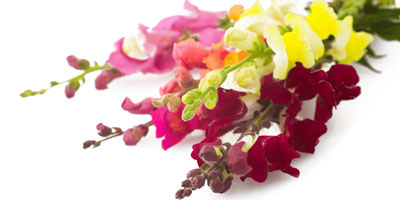
Snapdragons are a reliable and productive choice for a cut flower garden, with their long-stemmed, cut-and-come-again flowers that bloom for many months each spring and summer. Do you remember, when, as a child, you pinched the bottom of a Snapdragon blossom to watch it open its mouth? As an adult, you can have a bit of child-like fun by growing them in abundance in your garden and if you’ve never had the pleasure of ‘pinching’ a Snapdragon…you’re in for a treat. Growing on tall spikes, similar to Delphiniums, the similarity stops there. Snapdragon flowers are in a class all their own and are immediately recognizable. To increase the number of stems and blooms on your plants, pinch off the tips when the plants have 5 sets of true leaves (the first leaves that appear, usually in groups of 3, after the seedling leaves); be sure to only pinch off down to 2 sets of true leaves, leaving 3 sets behind. This will encourage your plants to branch and produce more flowers. To maximize their vase life, harvest snapdragons when just 1 or 2 florets are open and use floral preservative in the water for a lifespan of 7–10 days. Snapdragon plants are a tender perennial, putting on their best show in USDA Zones 7–11.

Gomphrena, or Globe Amaranth, is a late-summer favorite with adorable, button-like blooms, resembling clover blossoms, and are a nice addition to vase arrangements to add a different texture. This annual flowering plant has fuzzy white leaves when they first appear, eventually turning green, but keeping that tell-tale fuzz. These heat-loving plants are naturally branching, so no pinching is required. Gomphrena is known for its long vase life, with freshly harvested flowers lasting up to 2-weeks without preservative. Bunches of Globe Amaranth can be dried for more permanent flower arrangements. Hang the bunches upside down, out of direct sunlight and with good airflow. Experts recommend running a fan to keep that air flowing and to speed the drying process. Gomphrena flowers take around 2-weeks to dry.
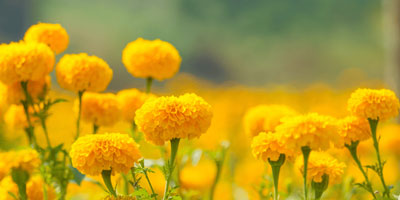
Marigolds, though many would not consider them a vase flower, are tough and abundant flowering plants, often producing 15-20 blossoms per plant. Marigolds today are not your grandma’s Marigold. Widely available in fall-like colors, the newest cultivars come in all shapes and forms, in many hues, some being beautifully bi-colored. You may also like to know that planting Marigolds, even around your vegetable garden, will repel mosquitoes, squash bugs and tomato hornworms, just to name a few. Marigolds are an annual that are highly popular as a bedding plant. It is true that Marigold flowers have a somewhat musky scent, similar to wet hay or straw, but when combined with other fragrant flowers, that aroma will blend well for an overall pleasant experience. Pinching the first new buds of each stem will encourage more blossoming stems to fill your garden spaces more quickly. These sturdy flowers are great for mixed bouquets, grow well in USDA Zones 2–11, especially during the warmer months, and can last for 7-10 days in the vase; no floral preservative is recommended.
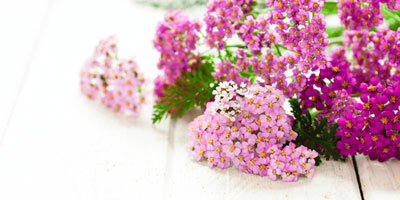
Yarrow is another great choice for a cut flower garden, with its stunning range of colors and easily identifiable flat-topped flower heads. Yarrow, also known as Achillea, is one of the longest blooming choices for your garden, flowering from April to October. Yarrow plants are perennial, tall, and aromatic, while their leaves are feathery looking, which will add fantastic texture to your cut flower arrangements. This drought-tolerant plant is easy to grow in full sun and spreads by self-sowing its seeds and underground stems. Spent flowers should be deadheaded if you wish to prevent self-sowing. Cut Yarrow stems when at least 3/4 of the florets are open on the flower head and when pollen is visible. The flowers will wilt if cut too early and will most likely not recover. When grown from seed, Yarrow plants may not bloom the first season, so we recommend more established plants to reap full blossoms the first year. Yarrow can be grown as far north as USDA Zone 2 and as far south as Zone 10 but will perform best in Zones 3–9.

Sunflowers are a popular choice for cut flower gardens due to their easy growth, sturdy stems, and abundant blossoms. Native to North America and Mexico, there are at least 52 species of Sunflower plants, with choices of stem length from short to tall, and choices of colors from very pale, creamy yellow to chocolate brown. They thrive in the hot summer and early autumn months, requiring minimal care, though the tallest varieties may need support as the Sunflower heads can be too heavy for the stems. To ensure a continuous harvest, consider sowing successive plantings of sunflowers every 7 to 10 days during the spring and early summer. When choosing varieties for your cut flower garden, you may want to look for pollenless cultivars unless you love having your tabletops decorated with yellow pollen. To get the longest vase life from your sunflowers, harvest them as soon as the first petals begin to unfurl. The vase life of Sunflowers can vary between 4 days to 2-weeks. When putting the stems in water, be sure to strip off the bottom three-fourths of the leaves. No flower preservative is needed.
Step Three: Plan for proper care:
Cut flowers will require regular watering and fertilizing, while some will benefit from deadheading (removing spent blooms) to thrive. Spending a bit of time in your cut flower garden in the early mornings can be a great way to wake up. You can also get a bit of exercise by pulling those pesky weeds each morning as they appear. This is a win-win, as your flower garden will remain its healthiest and be more attractive.
By choosing the right location, selecting a variety of flowers, and planning for proper care, you’ll be well on your way to creating a beautiful and thriving cut garden full of gorgeous blossoms that you can cut and enjoy in arrangements and bouquets.





























































































































































































































































































































































































































































































































































































































































